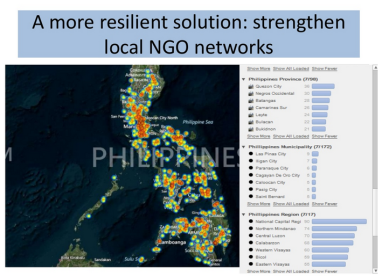analysis
15. From Typhoon Haiyan to Typhoon Hagupit: Reflections on a Year of Building Data Preparedness and Resilience Networks in the Philippines
Presenters: Mr. Andrew Schroeder, Director of Research and Analysis, Direct Relief; Mr. Justin Richmond, Mission Specialist, Palantir Technologies
 Thursday, 30 April 2015, 11:50-12:20
Thursday, 30 April 2015, 11:50-12:20
The session presented findings from collaborative data preparedness and community resilience work between the milestones of Typhoons Haiyan and Hagupit in the Philippines.
During Typhoon Haiyan, Direct Relief and Palantir partnered on the MIMOSA (MIniature MObile SAtellite) project for real-time collection of needs assessment data via satellite-connected SMS. Data from the community and infrastructure assessments was integrated via the Palantir Gotham software with open data on international response actors via OCHA and the NDRRMC to gain dynamic understanding of where the response was concentrated relative to storm impacts.
In part on the basis of post-Haiyan findings from the MIMOSA data, which indicated significant gaps between the international response and the needs of many communities, Direct Relief teamed up again with Palantir throughout 2014 to expand data-driven resilience activities with local partners, particularly the Filipino voluntary organization Gawad Kalinga. The goals of this activity have been:
- Staging data collection and analysis tools with regional leads through the country,
- Improving network-independent data collection through integration with ODK (Open Data Kits)
- Establishment of viable community and health assessment ontologies
- Creation of data sharing arrangements prior to the onset of new events
As a result of these activities Gawad Kalinga is beginning to collect baseline data from as many as 20,000 barangays and to create new community-level data collection and analysis practices. These new arrangements have already been put to the test during response to Typhoon Hagupit in December 2014, producing a wealth of insight into how we might best help to improve disaster response through flexible, technologically-enabled, locally-driven and internationally supported efforts.
Mr. Andrew Schroeder, Director of Research and Analysis, Direct Relief
 Andrew Schroeder is the Director of Research and Analysis at Direct Relief. He specializes in geographic information systems (GIS) for humanitarian operations and global public health. Andrew and Direct Relief were recognized in 2013 for this work with the President’s award from Esri, and again in 2015 with Esri’s special achievement in GIS award. Andrew is currently engaged in a wide range projects, from the evaluation of global drug donation programs to the use of unmanned aerial vehicles for disaster response to the deployment of GIS tools to track and count community health workers to the implementation of spatial analysis in the national laboratory systems of Ethiopia and Indonesia. He has worked on analytics for disaster relief in crises ranging from Typhoon Haiyan in the Philippines to Hurricane Sandy in New York and the Haiti earthquake. In 2014 he founded the Nethope working group in humanitarian UAVs and joined the advisory board of UAViators. He also serves on the global advisory board to the One-Million Community Health Workers Campaign. Andrew received his PhD from New York University’s Department of Social and Cultural Analysis and his Masters in Public Policy from the Ford School at the University of Michigan.
Andrew Schroeder is the Director of Research and Analysis at Direct Relief. He specializes in geographic information systems (GIS) for humanitarian operations and global public health. Andrew and Direct Relief were recognized in 2013 for this work with the President’s award from Esri, and again in 2015 with Esri’s special achievement in GIS award. Andrew is currently engaged in a wide range projects, from the evaluation of global drug donation programs to the use of unmanned aerial vehicles for disaster response to the deployment of GIS tools to track and count community health workers to the implementation of spatial analysis in the national laboratory systems of Ethiopia and Indonesia. He has worked on analytics for disaster relief in crises ranging from Typhoon Haiyan in the Philippines to Hurricane Sandy in New York and the Haiti earthquake. In 2014 he founded the Nethope working group in humanitarian UAVs and joined the advisory board of UAViators. He also serves on the global advisory board to the One-Million Community Health Workers Campaign. Andrew received his PhD from New York University’s Department of Social and Cultural Analysis and his Masters in Public Policy from the Ford School at the University of Michigan.
Mr. Justin Richmond, Mission Specialist, Palantir Technologies
Justin Richmond is currently a forward deployed engineer at Palantir Technologies as well as a Truman National Security Project Fellow. At Palantir, he led the field implementation for the Typhoon Haiyan and Typhoon Hagupit responses in the Philippines. Justin is currently working on data-driven countering violent extremism (CVE) programming in Iraq. He has appeared on BBC World News Service, CCTV’s Cultural Hour, and Radio Sawa speaking on East Asian security issues, North Korea, and nuclear nonproliferation.
Before joining Palantir, Justin deployed to Afghanistan to serve as USAID’s District Stability Framework coordinator to civilian District Support Teams and tactical military units. In that role, he advised and mentored joint civilian/military/Afghan teams on stabilization implementation, and monitoring and evaluation in eastern Afghanistan’s most contested districts.
Justin has worked extensively with local populations in northeastern China, South Korea, and throughout the Philippines. Justin also served in the U.S. Army, first as an Airborne Infantryman and then as a special operations team leader in the southern Philippines in 2009, where he focused on stabilization, counterinsurgency, and information operations. He received his B.A. in Public Policy studies from Duke University in 2005 and is a fluent Korean speaker.
Links to related material:
Direct Relief
Mimosa Project
Palantir Technologies
Palantir Disaster Preparedness